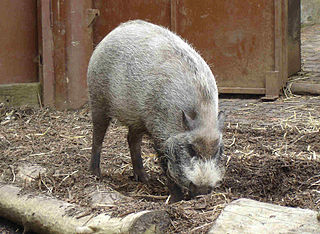
Suidae is a family of artiodactyl mammals which are commonly called pigs, hogs or swine. In addition to numerous fossil species, 18 extant species are currently recognized, classified into between four and eight genera. Within this family, the genus Sus includes the domestic pig, Sus scrofa domesticus or Sus domesticus, and many species of wild pig from Europe to the Pacific. Other genera include babirusas and warthogs. All suids, or swine, are native to the Old World, ranging from Asia to Europe and Africa.

Carcharhinus is the type genus of the family Carcharhinidae, the requiem sharks. One of 12 genera in its family, it contains over half of the species therein. It contains 35 extant and eight extinct species to date, with likely more species yet to be described.

The Kunekune is a small breed of domestic pig from New Zealand. Kunekune are hairy with a rotund build, and may bear wattles hanging from their lower jaws. Their colour ranges from black and white, to ginger, cream, gold-tip, black, brown, and tricoloured. They have a docile, friendly nature, and can successfully be kept as pets.

Suinae is a subfamily of artiodactyl mammals that includes several of the extant members of Suidae and their closest relatives – the domestic pig and related species, such as babirusas. Several extinct species within the Suidae are classified in subfamilies other than Suinae. However, the classification of the extinct members of the Suoidea – the larger group that includes the Suidae, the peccary family (Tayassuidae), and related extinct species – is controversial, and different classifications vary in the number of subfamilies within Suidae and their contents. Some classifications, such as the one proposed by paleontologist Jan van der Made in 2010, even exclude from Suinae some extant taxa of Suidae, placing these excluded taxa in other subfamilies.
Tetraconodontinae is an extinct subfamily of the pig family (Suidae). Fossils have been found in Africa and Asia.
Rhadalognathus was a prehistoric crocodile-like amphibian that belongs to the Mastodonsauridae family. Not much is known about this creature but it lived in the Triassic period. Rhadalognathus is also the name of the genus in which the organism belongs within. Rhadalognathus was found in northern Arizona, US, by S. P. Welles in 1947. The size of the organism is unknown but its skull is about 17in long and weighs 7lbs.

Hippohyini was an extinct tribe of Suinae which existed in Asia during the Pliocene.
Sivahyus was a genus of ground dwelling omnivorous even toed ungulates that existed in Asia during the Pliocene.
Cainochoerinae was a subfamily of even-toed ungulates that existed during the Miocene and Pliocene in Asia and Africa.
Albanohyus was an extinct genus of even-toed ungulates which lived during the Miocene in Eurasia and possibly Africa.
Cainochoerus was an extinct genus of even-toed ungulates which lived during the Miocene and Pliocene in Africa. Fossils have been found in Kenya, Ethiopia and South Africa.

Hyotheriinae was a subfamily of even-toed ungulates that existed during the Miocene and Pliocene in Europe, Asia, and Africa.

Aureliachoerus was an extinct genus of suids that existed during the Miocene in Europe.
Xenohyus was an extinct genus of suids that existed during the Miocene in Europe.
Parachleuastochoerus was an extinct genus of even-toed ungulates that existed during the Miocene in Europe. It was a smaller descendant of the Conohyus genus, with narrower cheek teeth and reduced premolars.
Sivachoerus was an extinct genus of even-toed ungulates that existed during the Miocene in Europe.
Tetraconodon was an extinct genus of even-toed ungulates that existed during the middle and late Miocene in Asia.

Celebochoerus is an extinct genus of giant suid artiodactyl that existed during the Pliocene and Pleistocene in Sulawesi, Indonesia, and the middle Pleistocene of Luzon, in the Philippines.








